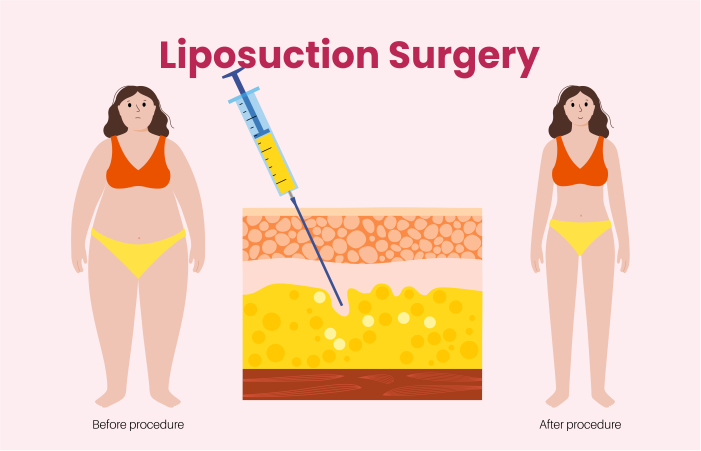Liposuction Surgery in Hyderabad

Liposuction Surgery in Hyderabad
Liposuction, also known as lipoplasty or suction-assisted lipectomy, is a surgical procedure aimed at reshaping and contouring the body by removing excess fat deposits. During the surgery, a small incision is made near the targeted area, and a thin tube called a cannula is inserted. The cannula is connected to a suction device, which gently suctions out the fat cells, creating a more sculpted appearance.

Purpose of Liposuction Surgery
Liposuction is performed to address localised areas of stubborn fat that are resistant to diet and exercise. It is commonly used to improve body proportions, enhance body contours, and achieve a more proportionate and balanced appearance. Liposuction is typically performed on areas such as the abdomen, thighs, hips, buttocks, arms, back, and chin.
How to Prepare for Liposuction Surgery
Preparing for liposuction surgery involves several important steps. You will have an initial consultation with a plastic surgeon who will assess your overall health, discuss your goals and expectations, and determine if you are a suitable candidate for the procedure. The surgeon may request medical tests and evaluations to ensure you are physically prepared for the surgery.
Before the procedure, your surgeon will provide specific instructions tailored to your needs. These may include avoiding certain medications, adjusting your diet, quitting smoking, and arranging for someone to accompany you on the day of surgery and assist you during the initial recovery period.
More About Liposuction Surgery
Liposuction can be performed using various techniques, including the traditional method and newer approaches such as laser liposuction. Laser liposuction, also known as laser-assisted liposuction or SmartLipo, utilizes laser energy to liquefy fat cells before suctioning them out. This technique may offer certain advantages, such as reduced bleeding and improved skin tightening.
During the liposuction procedure, the surgeon will make small incisions strategically placed near the treatment areas. They will then insert the cannula to target and remove the excess fat. The length of the procedure depends on the extent of the treatment areas and the amount of fat being removed.
Consequences of Liposuction Surgery
While liposuction is generally considered safe, it is important to be aware of potential consequences and risks associated with the procedure. These may include:
- Swelling and Bruising: It is common to experience temporary swelling, bruising, and discomfort after liposuction. The use of compression garments and following post-operative instructions can help minimize these effects.
- Irregular Contour or Uneven Results: In some cases, uneven fat removal or contour irregularities may occur. However, these can often be addressed with additional treatments or revisions.
- Infection and Fluid Accumulation: Although rare, infection and fluid accumulation (seroma) are possible complications of liposuction. Proper wound care and following the surgeon’s instructions can help minimize these risks.
- Skin Irregularities: Liposuction may result in changes to the skin texture, such as dimpling or sagging. Your surgeon will assess your skin elasticity before the procedure to determine the likelihood of these outcomes.
Frequently Asked Questions (FAQs)
Liposuction surgery, also known as lipoplasty or suction-assisted lipectomy, is a cosmetic procedure that removes excess fat deposits from specific areas of the body. During the surgery, a small incision is made near the targeted area, and a thin tube called a cannula is inserted to suction out the fat cells, reshaping and contouring the body.
Liposuction surgery is typically recommended for individuals who are close to their ideal body weight but have localized areas of stubborn fat that are resistant to diet and exercise. It is important to have good overall health, realistic expectations, and a commitment to maintaining a healthy lifestyle after the procedure.
Liposuction can be performed on various areas of the body, including the abdomen, hips, thighs, buttocks, arms, back, and chin. The specific treatment areas will be discussed during your consultation with a qualified plastic surgeon, who will assess your individual needs and goals.
The recovery period can vary depending on the extent of the procedure and the individual’s healing process. Generally, patients can expect some swelling, bruising, and discomfort in the treated areas. Most individuals can resume light activities within a few days and return to normal activities within a few weeks. It is important to follow the surgeon’s post-operative instructions and wear compression garments as advised.
The fat cells removed during liposuction surgery are permanently eliminated from the treated areas. However, it is important to maintain a healthy lifestyle with regular exercise and a balanced diet to prevent new fat deposits from forming. Weight gain after liposuction can affect the overall appearance, so it is essential to maintain a stable weight to enjoy long-lasting results.









